A Nodal Analysis Based Monitoring of an Electric Submersible Pump Operation in Multiphase Flow
Abstract
:Featured Application
Abstract
1. Introduction
2. Multiphase Surging Empirical Model Review
3. ESP Fault Monitoring and Diagnosis Review
4. Materials and Methods
4.1. Model Formulation
4.2. The Homogenous Model
4.3. Nodal Analysis Simulation
4.4. Model Validation and Interpretation
5. Results
5.1. Results of Nodal Analysis Simulation
5.2. ESP Operation as and PIP Deviate
5.3. Comparison of Nodal Analysis and Surging Prediction Models
5.4. Changes in the PIP and —A Field Example
5.5. Model Assessment
6. Conclusions and Recommendation
- (1)
- Nodal analysis precisely predicted ESP operating conditions by matching real-time downhole and surface sensor data trends. Nodal analysis can be used for real-time monitoring of ESP wells.
- (2)
- Nodal analysis can be used to manage future ESP wells; the normal operating ranges are based on the natural conditions of the well. Such proactive planning prevents uncertainties that might otherwise arise when an ESP is installed.
- (3)
- The nodal analysis allows quick diagnosis and interpretation of downhole sensor data, facilitating rapid responses to ESP conditions that might otherwise damage the pump.
- (4)
- We add to the current body of ESP well-monitoring knowledge.
Author Contributions
Funding
Institutional Review Board Statement
Informed Consent Statement
Data Availability Statement
Conflicts of Interest
References
- Peng, L.; Han, G.; Sui, X.; Pagou, A.L.; Zhu, L.; Shu, J. Predictive approach to perform fault detection in electrical submersible pump systems. ACS Omega 2021, 6, 8104–8111. [Google Scholar] [CrossRef] [PubMed]
- Vald, J.P.; Becerra, D.; Rozo, D.; Cediel, A.; Torres, F.; Asuaje, M.; Sim, U. Comparative analysis of an electrical submersible pump’ s performance handling viscous Newtonian and non-Newtonian fluids through experimental and CFD approaches. J. Pet. Sci. Eng. 2020, 187, 106749. [Google Scholar] [CrossRef]
- Ofuchi, E.M.; Stel, H.; Vieira, T.S.; Ponce, F.J.; Chiva, S.; Morales, R.E.M. Study of the effect of viscosity on the head and fl ow rate degradation in different multistage electric submersible pumps using dimensional analysis. J. Pet. Sci. Eng. 2017, 156, 442–450. [Google Scholar] [CrossRef]
- Ali, A.; Yuan, J.; Deng, F.; Wang, B.; Liu, L.; Si, Q.; Buttar, N.A. Research progress and prospects of multi-stage centrifugal pump capability for handling gas-liquid multiphase flow: Comparison and empirical model validation. Energies 2021, 14, 896. [Google Scholar] [CrossRef]
- Takacs, G. Submersible Electrical Pumps Manual: Design, Operations and Maintenance, 2nd ed.; Elsevier: Amsterdam, The Netherlands, 2018; ISBN 9780128145708. [Google Scholar]
- Nguyen, T.C.; Pande, S.; Bui, D.; Al-Safran, E.; Nguyen, H.V. Pressure dependent permeability: Unconventional approach on well performance. J. Pet. Sci. Eng. 2020, 193, 107358. [Google Scholar] [CrossRef]
- Manshad, A.K.; Dastgerdi, M.E.; Ali, J.A.; Mafakheri, N.; Keshavarz, A.; Iglauer, S.; Mohammadi, A.H. Economic and productivity evaluation of different horizontal drilling scenarios: Middle East oil fields as case study. J. Pet. Explor. Prod. Technol. 2019, 9, 2449–2460. [Google Scholar] [CrossRef] [Green Version]
- Clegg, J.D. Operations Petroleum Engineering Production Operations Engineering; Society of Petroleum Engineers: Richardson, TX, USA, 2007; Volume IV, ISBN 978-1-55563-118-5. [Google Scholar]
- Kolawole, O.; Gamadi, T.D.; Bullard, D. Artificial lift system applications in tight formations: The state of knowledge. SPE Prod. Oper. 2020, 35, 422–434. [Google Scholar] [CrossRef]
- Stel, H.; Sirino, T.; Ponce, F.J.; Chiva, S.; Morales, R.E.M. Numerical investigation of the flow in a multistage electric submersible pump. J. Pet. Sci. Eng. 2015, 136, 41–54. [Google Scholar] [CrossRef]
- Zhu, J.; Guo, X.; Liang, F.; Zhang, H.Q. Experimental study and mechanistic modeling of pressure surging in electrical submersible pump. J. Nat. Gas Sci. Eng. 2017, 45, 625–636. [Google Scholar] [CrossRef]
- Lea, J.F.; Bearden, J.L. Effect of Gaseous Fluids on Submersible Pump Performance. JPT J. Pet. Technol. 1982, 34, 2922–2930. [Google Scholar] [CrossRef]
- Gamboa, J.; Prado, M. Review of electrical-submersible-pump surging correlation and models. SPE Prod. Oper. 2011, 26, 314–324. [Google Scholar] [CrossRef]
- Zhou, D.; Sachdeva, R. Simple model of electric submersible pump in gassy well. J. Pet. Sci. Eng. 2010, 70, 204–213. [Google Scholar] [CrossRef]
- Turpin, J.L.; Lea, J.F.; Bearden, J.L. Gas-liquid flow through centrifugal pumps—correlation of data. In Proceedings of the 3rd International Pump Symposium, Texas A&M University, College Station, TX, USA, 1 May 1986. [Google Scholar]
- Pessoa, R.; Prado, M. Experimental investigation of two-phase flow performance of electrical submersible pump stages. In Proceedings of the SPE Annual Technical Conference and Exhibition, New Orleans, LA, USA, 30 September–3 October 2001. [Google Scholar] [CrossRef]
- Cirilo, R. Air-water Flow Through Electric Submersible Pumps; Artificial Lift Projects Research Report; University of Tulsa: Tulsa, OK, USA, 1998. [Google Scholar]
- Romero, M. An Evaluation of An Electrical Submersible Pumping System for High Gor Wells. Master’s Thesis, University of Tulsa, Tulsa, OK, USA, 1999. [Google Scholar]
- Duran, J.; Prado, M. ESP Stages air-water two-phase performance-modeling and experimental data. SPE J. 2003, 13, 196105718. [Google Scholar]
- Zhu, J.; Zhang, J.; Cao, G.; Zhao, Q.; Peng, J.; Zhu, H.; Zhang, H.Q. Modeling flow pattern transitions in electrical submersible pump under gassy flow conditions. J. Pet. Sci. Eng. 2019, 180, 471–484. [Google Scholar] [CrossRef]
- Zhu, J.; Zhang, H.Q. A review of experiments and modeling of gas-liquid flow in electrical submersible pumps. Energies 2018, 11, 180. [Google Scholar] [CrossRef] [Green Version]
- Diaz, N.I.C. Effects of Sand on the Components and Performance of Electrical Submersible Pumps. Master’s Thesis, Texas A&M University, College Station, TX, USA, 2012. [Google Scholar]
- Jansen van Rensburg, N. Usage of artificial intelligence to reduce operational disruptions of ESPs by implementing predictive maintenance. In Proceedings of the Abu Dhabi International Petroleum Exhibition & Conference, Abu Dhabi, United Arab Emirates, 12–15 November 2018. [Google Scholar] [CrossRef]
- Oyewole, P. Application of real-time ESP data processing and interpretation in Permian basin “brownfield” operation. In Proceedings of the International Petroleum Technology Conference, Doha, Qatar, 21–23 November 2005. [Google Scholar] [CrossRef]
- Awaid, A.; Al-Muqbali, H.; Al-Bimani, A.; Al-Yazeedi, Z.; Al-Sukaity, H.; Al-Harthy, K.; Baillie, A. ESP well surveillance using pattern recognition analysis, oil wells, Petroleum Development Oman. In Proceedings of the International Petroleum Technology Conference, Doha, Qatar, 19–22 January 2014. [Google Scholar] [CrossRef]
- Al-sadah, H.; Khamseen, M.A.; Al-ghamdi, A.; Fardan, A.; Aramco, S. Proactive utilization of ESP performance monitoring to enhance productivity. In Proceedings of the SPE Middle East Oil and Gas Show and Conference, Manama, Bahrain, 18–21 March 2019. [Google Scholar] [CrossRef]
- Agrawal, N.; Chapman, T.; Baid, R.; Singh, R.K.; Shrivastava, S.; Kushwaha, M.K. ESP performance monitoring and diagnostics for production optimization in polymer flooding: A case study of Mangala field. In Proceedings of the SPE Oil and Gas India Conference and Exhibition, Mumbai, India, 9–11 April 2019. [Google Scholar] [CrossRef]
- Nunez, W.; Del Pino, J.; Gomez, S.; Rosales, D.; Puentes, J.; Rivera, H. Electric submersible pump troubleshooting guide, an effective way to improve system performance and reduce avoidable system failures. In Proceedings of the SPE Latin American and Caribbean Petroleum Engineering Conference, Vitrul, 20 July 2020. [Google Scholar] [CrossRef]
- Barrios Castellanos, M.; Serpa, A.L.; Biazussi, J.L.; Monte Verde, W.; do Socorro Dias Arrifano Sassim, N. Fault identification using a chain of decision trees in an electrical submersible pump operating in a liquid-gas flow. J. Pet. Sci. Eng. 2020, 184, 106490. [Google Scholar] [CrossRef]
- Liang, X.; Ghoreishi, O.; Xu, W. Downhole tool design for conditional monitoring of electricalsubmersible motors in oil field facilities. IEEE Trans. Ind. Appl. 2017, 53, 3164–3174. [Google Scholar] [CrossRef]
- Li, L.; Hua, C.; Xu, X. Condition monitoring and fault diagnosis of electric submersible pump based on wellhead electrical parameters and production parameters. Syst. Sci. Control Eng. 2018, 6, 253–261. [Google Scholar] [CrossRef]
- Fusiek, G.; Niewczas, P.; Judd, M.D. Towards the development of a downhole optical voltage sensor for monitoring electrical submersible pumps. Sens. Actuators A Phys. 2012, 184, 173–181. [Google Scholar] [CrossRef]
- Bruijnen, P.M. Nodal analysis by use of ESP intake and discharge pressure gauges. SPE Prod. Oper. 2016, 31, 76–84. [Google Scholar] [CrossRef]
- Dowling, M.A. You don’ t know pumps: Myths and truths about ESP operation in high-gas environments. In Proceedings of the SPE Electric Submersible Pump Symposium, The Woodlands, TX, UAS, 9–11 April 2019. [Google Scholar] [CrossRef]
- Pessoa, R.; Prado, M. Two-phase flow performance for electrical submersible pump stages. SPE Prod. Facil. 2003, 18, 13–27. [Google Scholar] [CrossRef]
- Babu, D.K.; Odeh, A.S. Productivity of a horizontal well. SPE Res. Eng. 1988, 4, 417–421. [Google Scholar] [CrossRef]
- Beggs, H.D.; Brill, J.R. Study of Two-Phase Flow in Inclined Pipes. JPT J. Pet. Technol. 1973, 25, 607–617. [Google Scholar] [CrossRef]
- Hagedorn, A.R.; Brown, K.E. Experimental Study of Pressure Gradients Occurring During Continuous Two-Phase Flow in Small-Diameter Vertical Conduits. J. Pet. Technol. 1965, 17, 475–484. [Google Scholar] [CrossRef]
- Camilleri, L.A.; Gong, H.; Al-Maqsseed, N.H.; Al-Jazzaf, A.M. Tuning VSDs in ESP wells to optimize oil production—case studies. In Proceedings of the SPE Artificial Lift Conference and Exhibition—Americas, The Woodlands, TX, USA, 28–30 August 2018. [Google Scholar] [CrossRef]

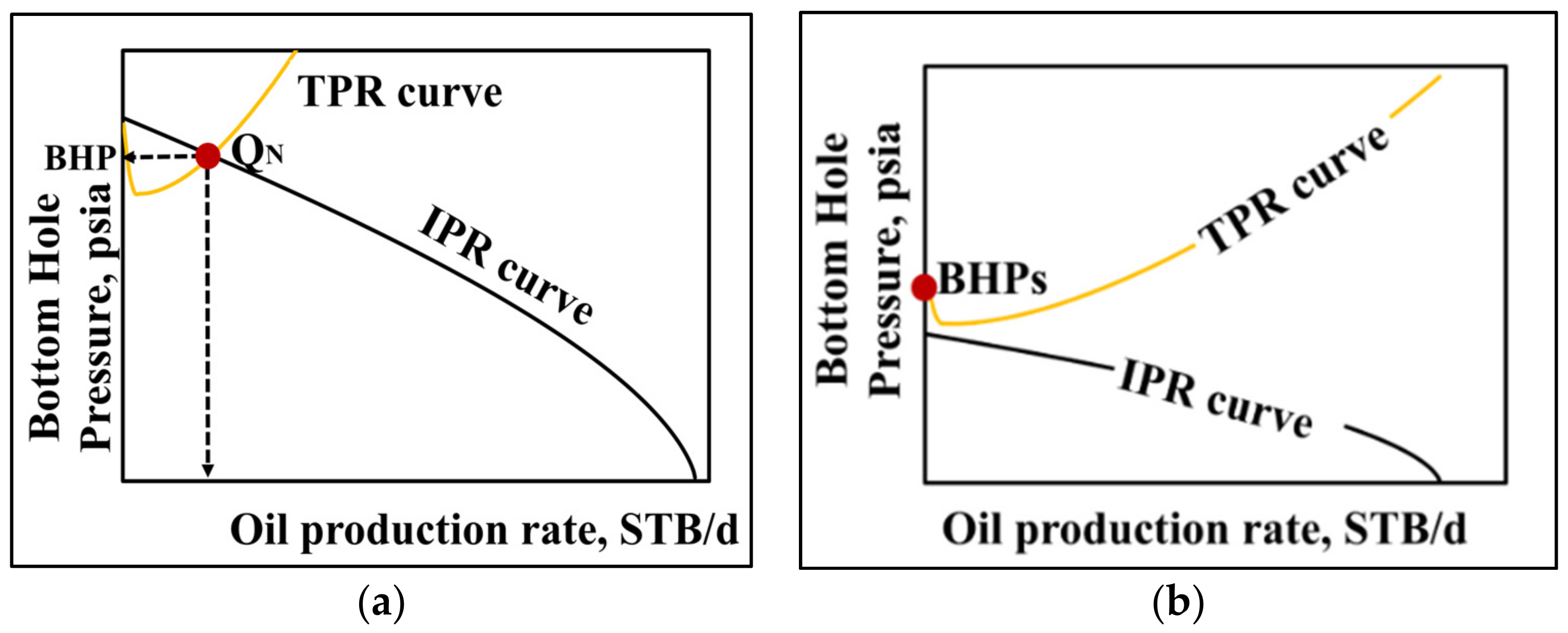

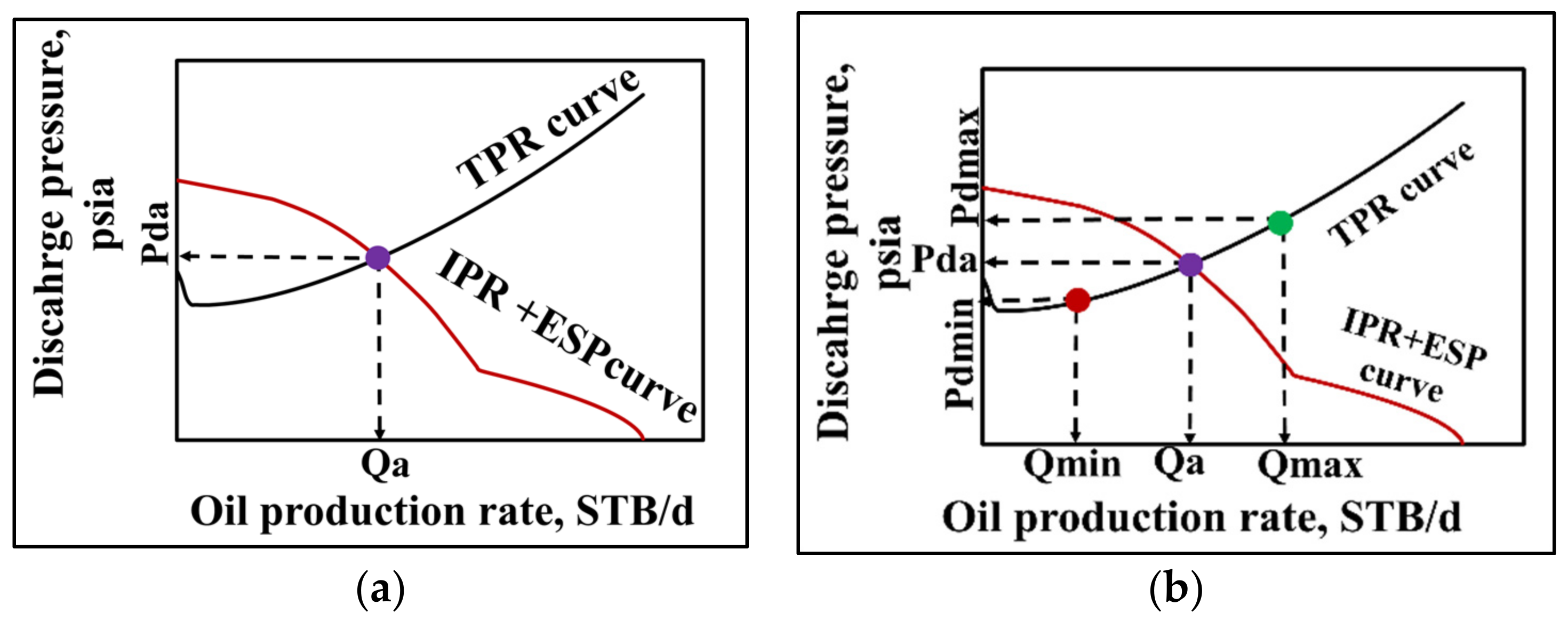
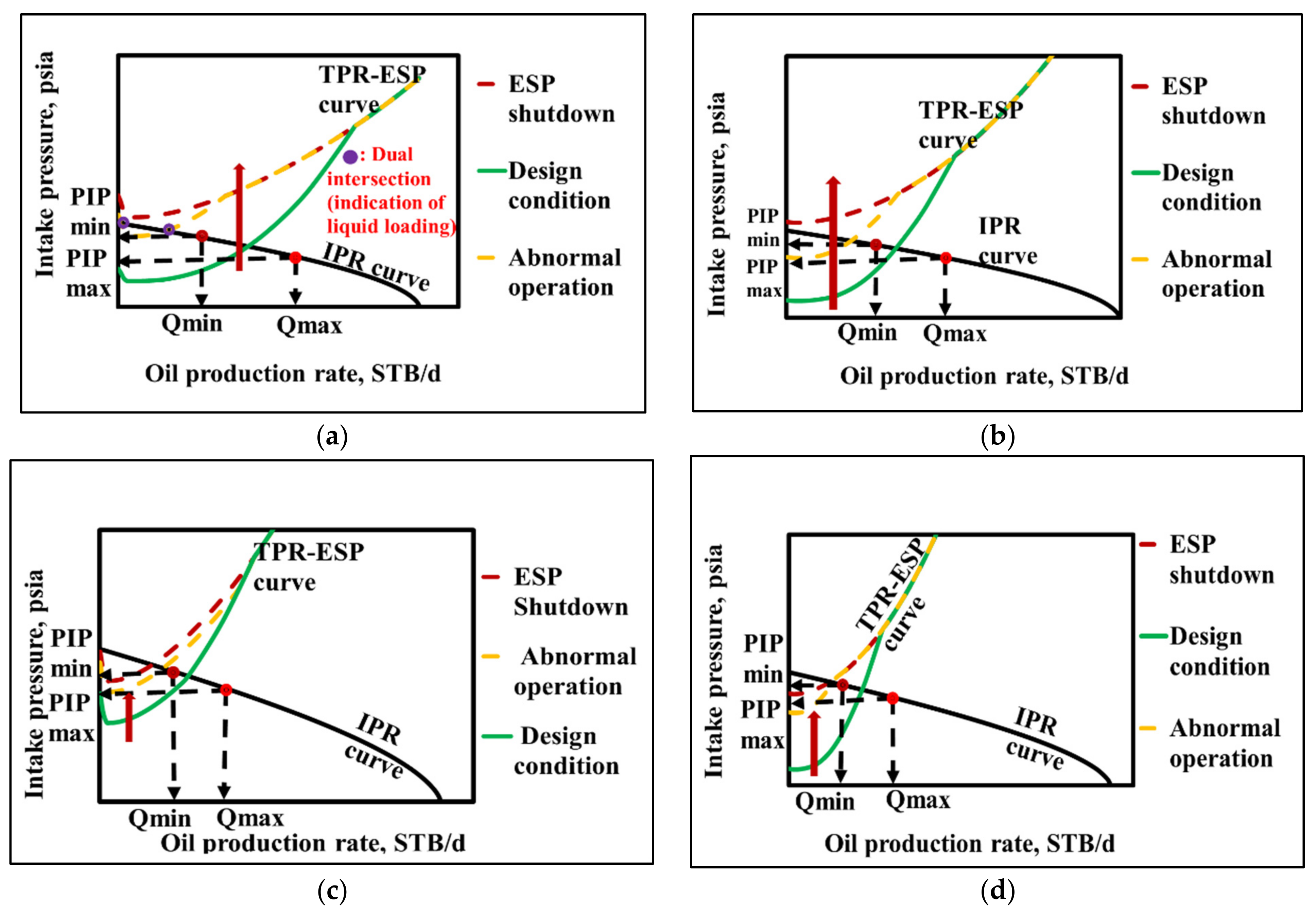
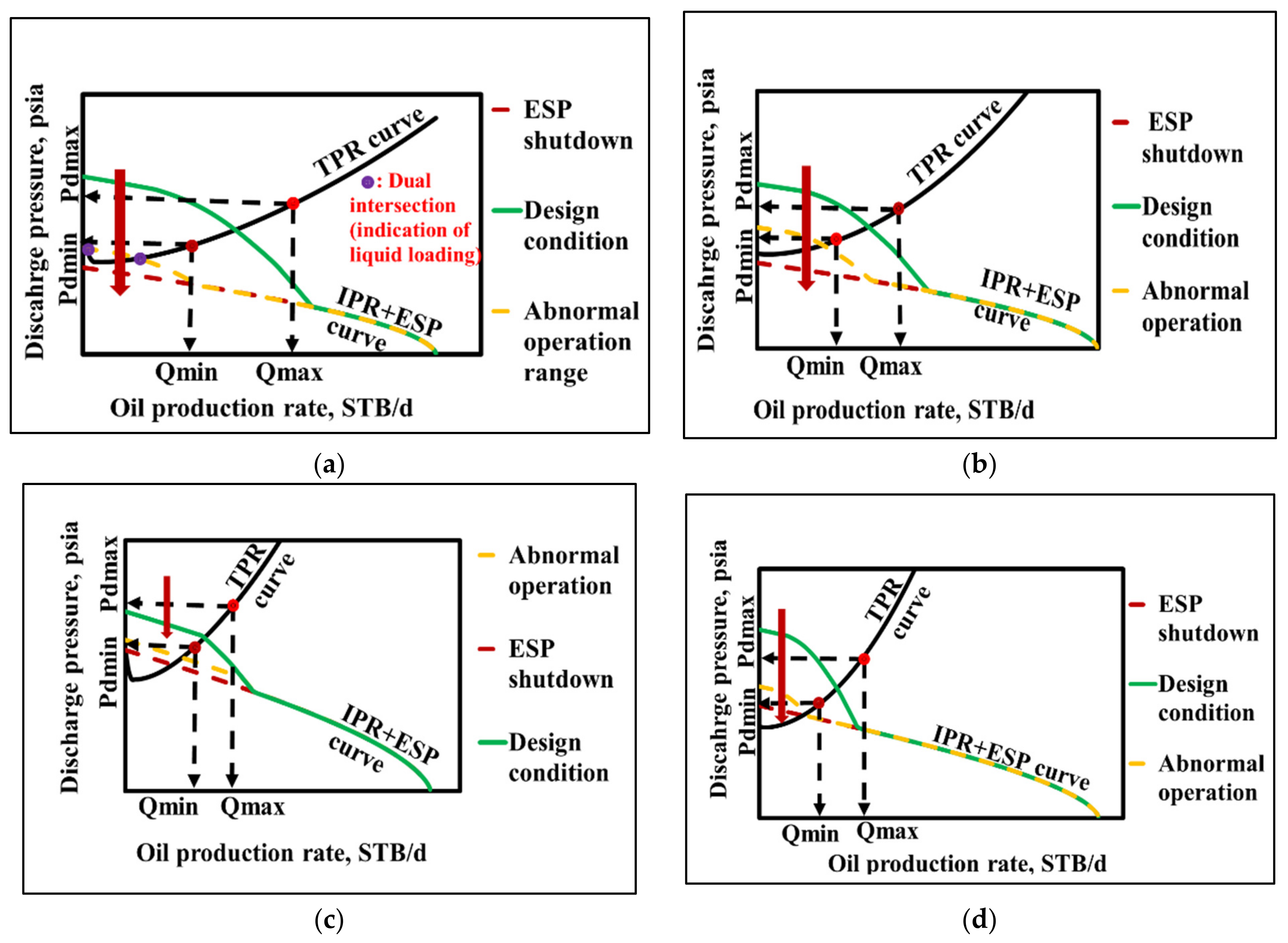
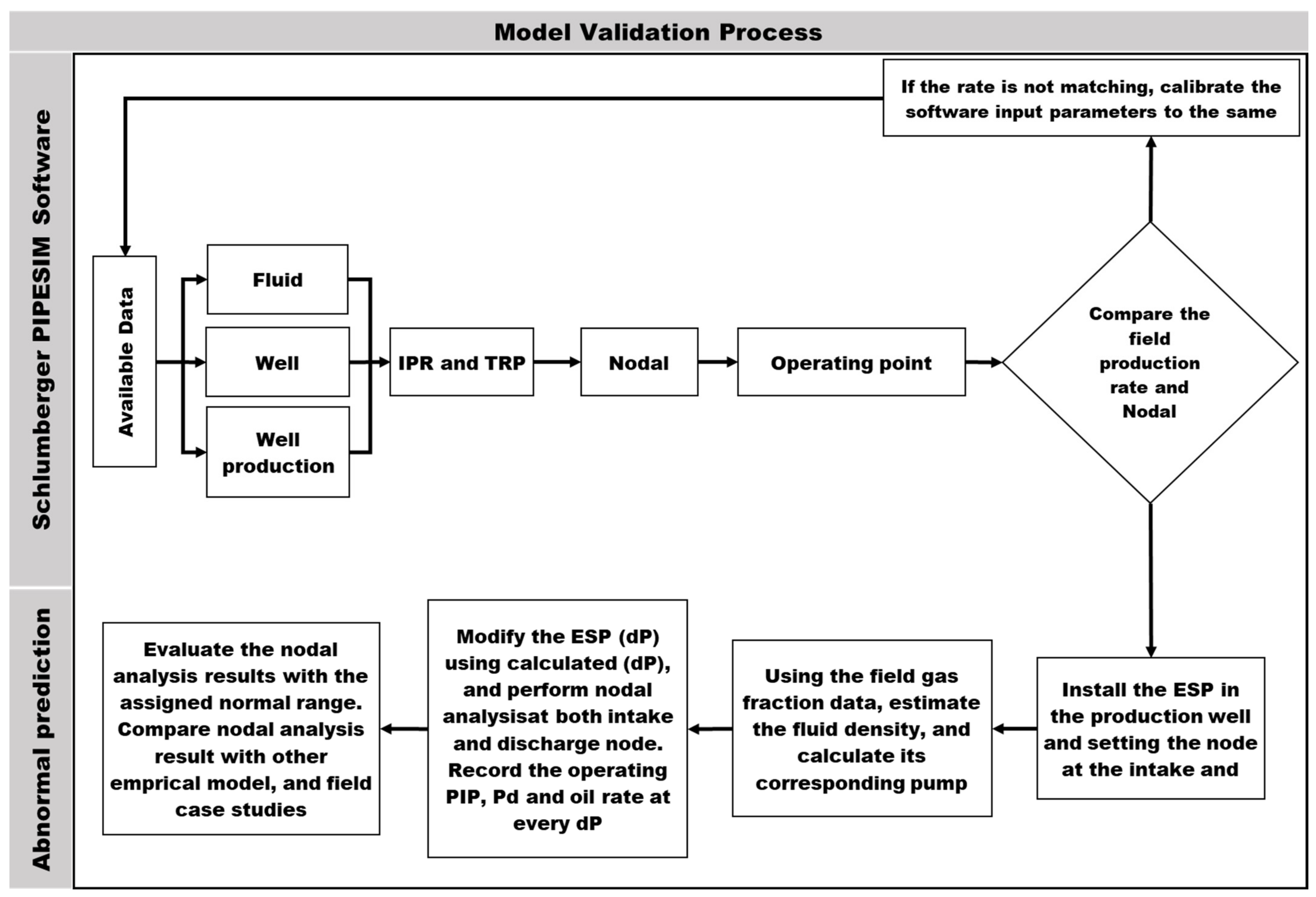
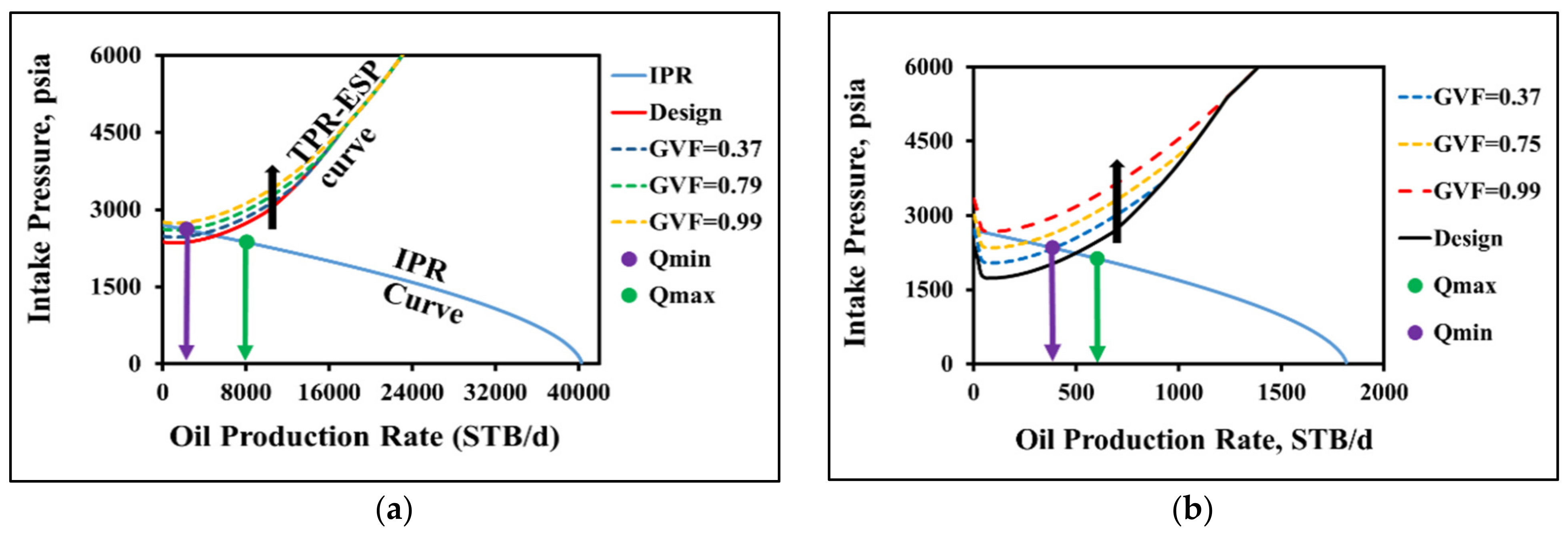
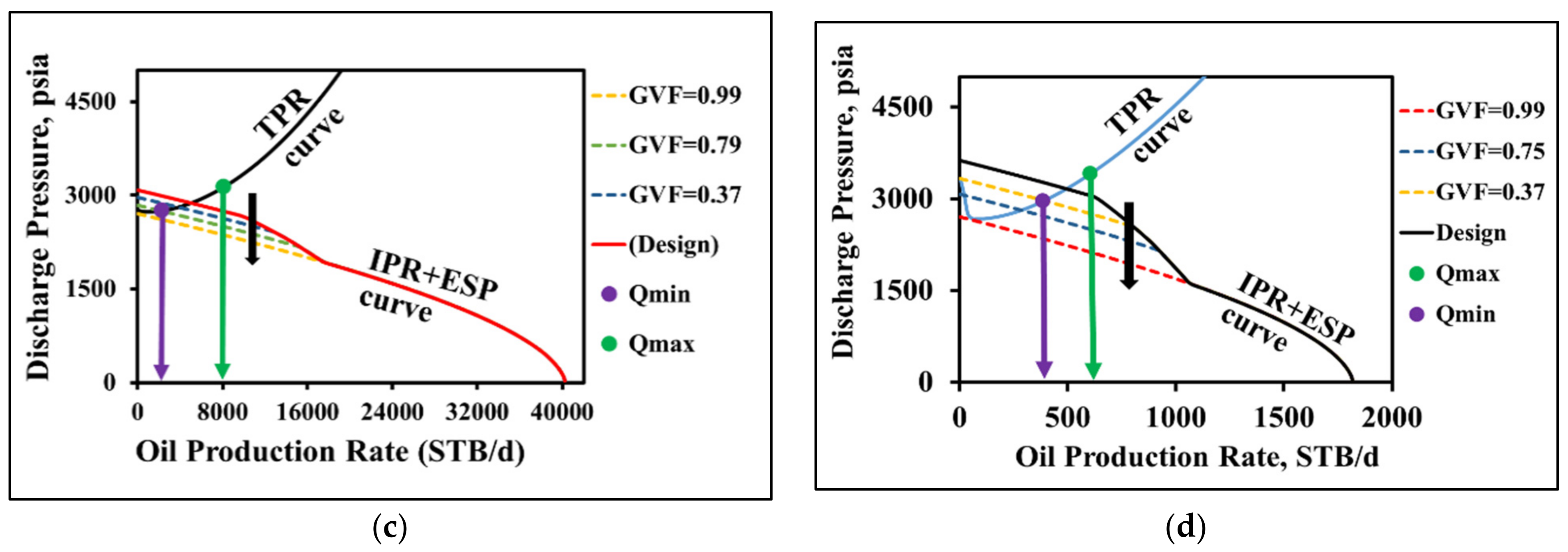

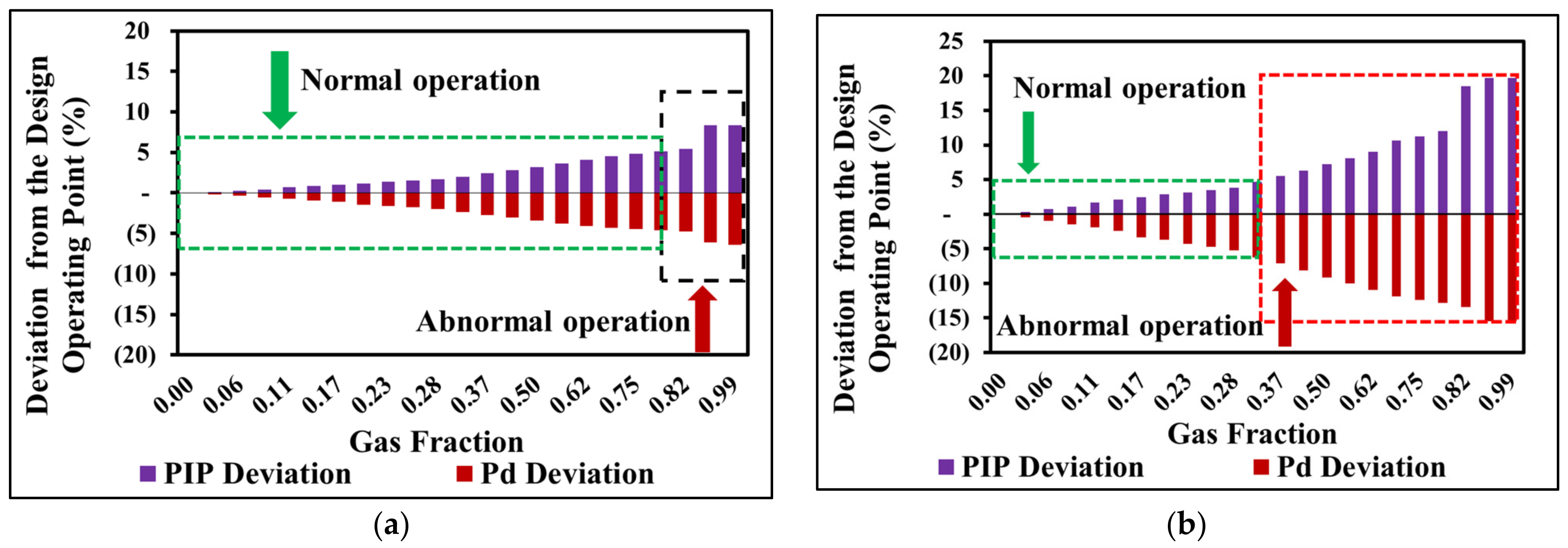
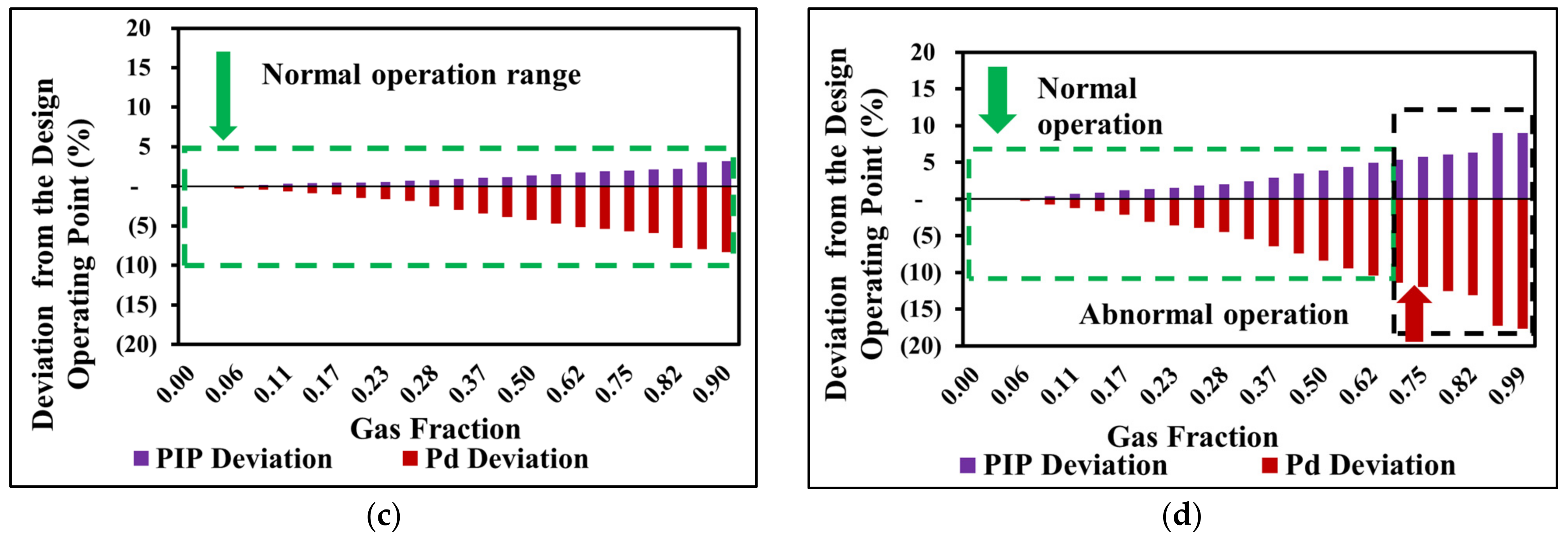
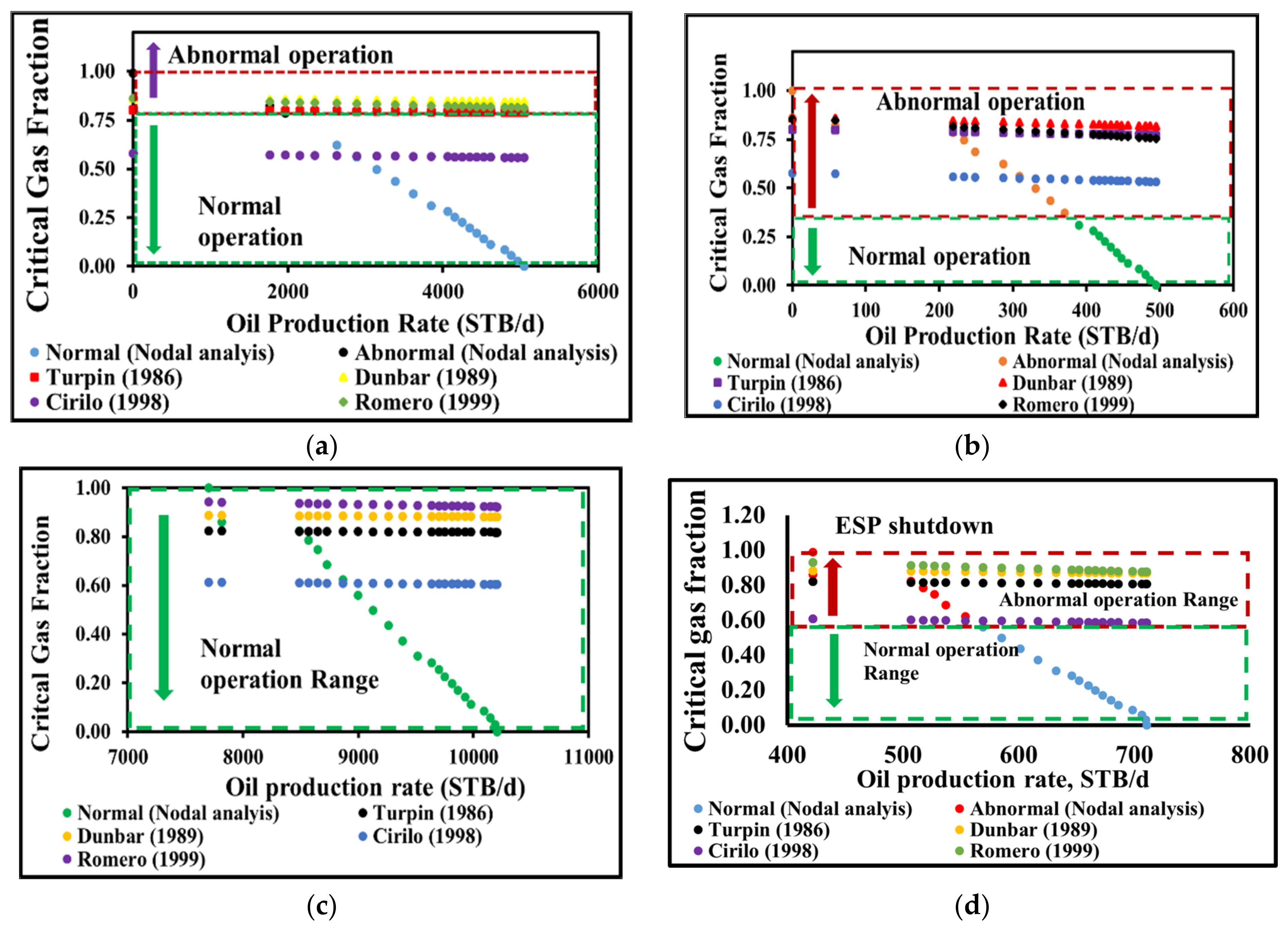
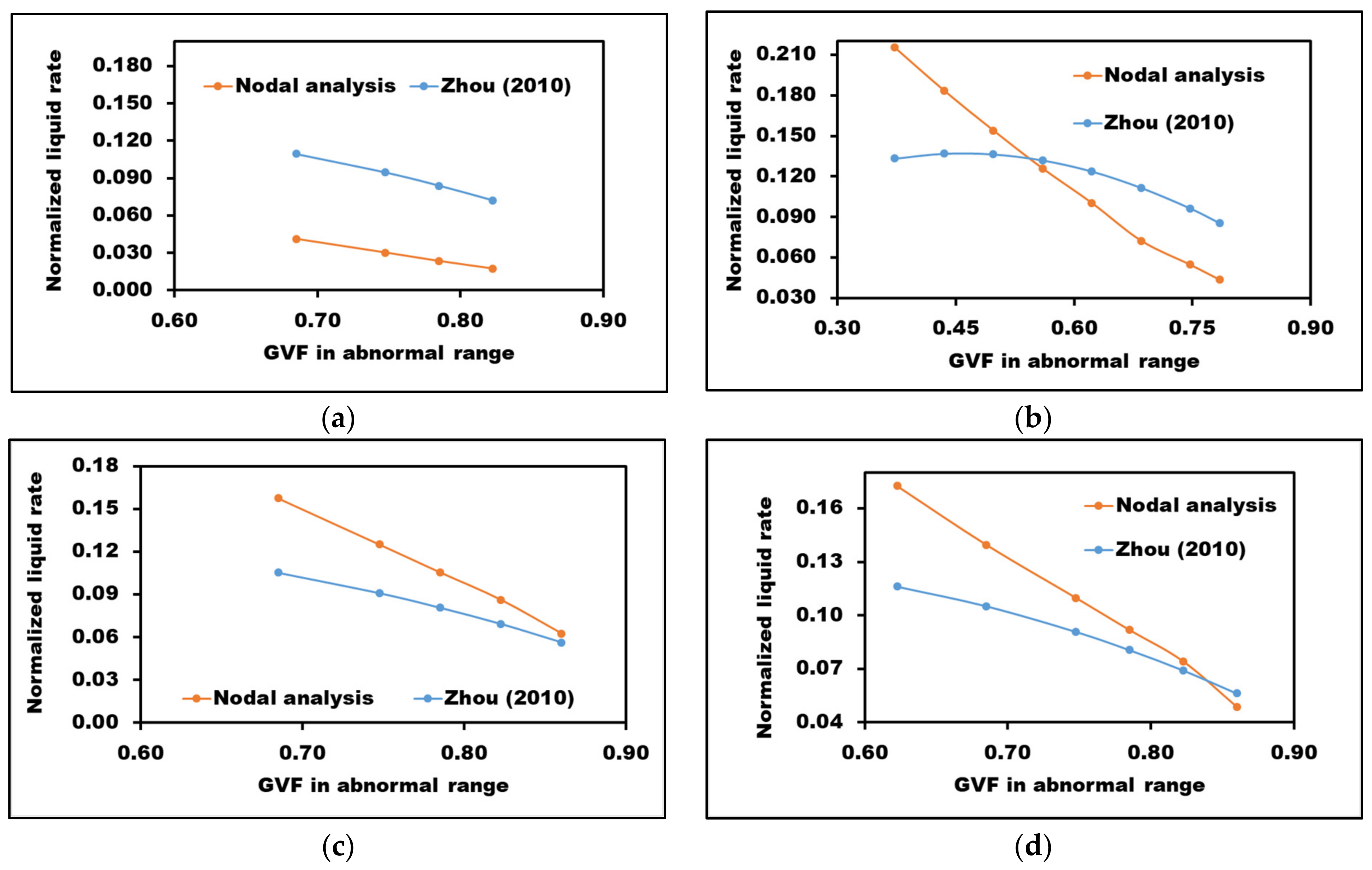

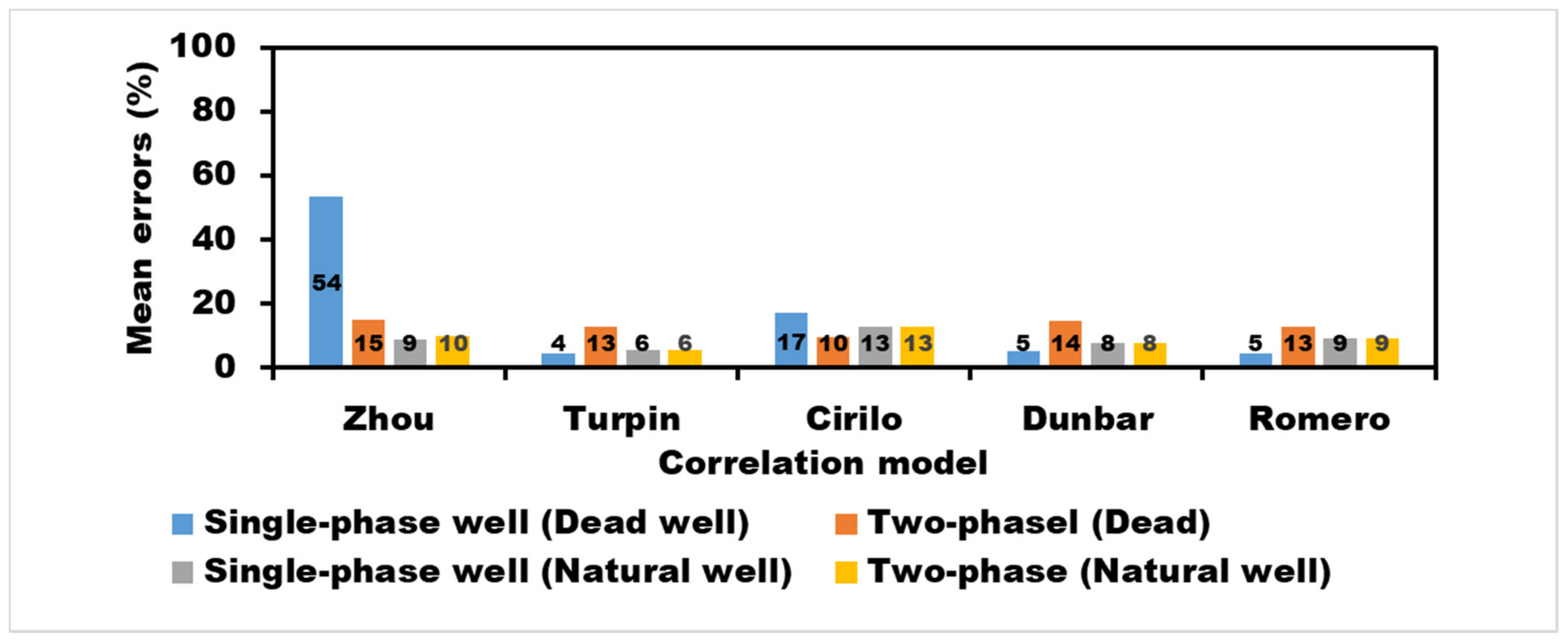
| Prediction Model | ESP Surging Correlation |
|---|---|
| Turpin et al. (1986) [15] | , initiation of abnormal operation ] |
| Dunbar (1989)-Pessoa (2001) [16] | |
| Cirilo (1998) [17] | |
| Romero (1999) [18] | |
| Duran (2003) [19] | is the maximum rate from the pump curve |
| Zhou (2010) [14] | For mixed flow pump [K-70] |
| Gamboa (2011) [13] | : impeller outlet diameter, m |
| Zhu (2017–2019) [11,20,21] | : represent rotator radius, m |
| Parameter | |
|---|---|
| Reservoir pressure (psia) | 3378.93 |
| Reservoir temperature (F) | 206 |
| Payzone thickness (ft) | 68 |
| Horizontal distance (ft) | 3901 |
| Well permeability, (kx, ky, kz, respectively) (md) | 0.05, 0.05, 0.05 |
| Water cut (%) | 92.9 |
| Gas oil ratio, GOR (SCF/STB) | 2218 |
| Gas SG | 0.65 |
| API | 42.98 |
| Well measured depth (MD) (ft) | 12,216 |
| Tubing measured depth (MD) (ft) | 7021 |
| Tubing ID (in) | 2.785 |
| Oil production rate (STB/d) | 430 |
| Type of Production Well | ESP Operating Condition | At PIP Node | At Pd Node |
|---|---|---|---|
| Natural flowing well (or dead well) | Normal | PIPmax < PIPa < PIPmin | Pdmax > Pda > Pdmin |
| The transition from normal to abnormal conditions (surging) | PIPa = PIPmin | Pda = Pdmin | |
| Abnormal operation | PIPa > PIPmin | Pda < Pdmin | |
| Gas locking (pump stopped); return to natural flow | PIPa = Pda = BHP | Pda = Pda = BHP |
| Correlation | Case 1a | Case 1b | Case 2a | Case 2b | ||||
|---|---|---|---|---|---|---|---|---|
| W | p-Value | W | p-Value | W | p-Value | W | p-Value | |
| Nodal analysis | 0.969 | 0.700 | 0.963 | 0.700 | 0.986 | 0.985 | 0.986 | 0.985 |
| Turpin (1986) | 0.829 | 0.075 | 0.953 | 0.700 | 0.847 | 0.300 | 0.874 | 0.300 |
| Cirilo (1998) | 0.777 | 0.035 | 0.952 | 0.700 | 0.846 | 0.300 | 0.873 | 0.300 |
| Dunbar(1989) | 0.870 | 0.300 | 0.953 | 0.700 | 0.847 | 0.300 | 0.857 | 0.300 |
| Romero (1999) | 0.876 | 0.300 | 0.952 | 0.700 | 0.845 | 0.300 | 0.872 | 0.300 |
| Correlation | Case 1a | Case 1b | Case 2a | Case 2b | ||||
|---|---|---|---|---|---|---|---|---|
| W | p-Value | W | p-Value | W | p-Value | W | p-Value | |
| Nodal analysis | 0.925 | 0.300 | 0.951 | 0.700 | 0.994 | 0.990 | 0.985 | 0.965 |
| Zhou (2010) | 0.913 | 0.300 | 0.852 | 0.300 | 0.995 | 0.700 | 0.982 | 0.965 |
| Correlation | Case 1a | Case 1b | Case 2a | Case 2b | ||||
|---|---|---|---|---|---|---|---|---|
| W | p-Value | W | p-Value | W | p-Value | W | p-Value | |
| Turpin (1986) | 0.03 | 1.00 | 0.11 | 1.00 | 0.05 | 1.00 | 0.05 | 1.00 |
| Cirilo (1998) | 0.02 | 1.00 | 0.09 | 1.00 | 0.04 | 1.00 | 0.04 | 1.00 |
| Dunbar (1989) | 0.03 | 1.00 | 0.11 | 1.00 | 0.06 | 1.00 | 0.06 | 1.00 |
| Romero (1999) | 0.02 | 1.00 | 0.14 | 1.00 | 0.05 | 1.00 | 0.05 | 1.00 |
| Zhou (2010) | 0.02 | 1.00 | 0.05 | 1.00 | 0.01 | 1.00 | 0.01 | 1.00 |
Publisher’s Note: MDPI stays neutral with regard to jurisdictional claims in published maps and institutional affiliations. |
© 2022 by the authors. Licensee MDPI, Basel, Switzerland. This article is an open access article distributed under the terms and conditions of the Creative Commons Attribution (CC BY) license (https://creativecommons.org/licenses/by/4.0/).
Share and Cite
Iranzi, J.; Son, H.; Lee, Y.; Wang, J. A Nodal Analysis Based Monitoring of an Electric Submersible Pump Operation in Multiphase Flow. Appl. Sci. 2022, 12, 2825. https://doi.org/10.3390/app12062825
Iranzi J, Son H, Lee Y, Wang J. A Nodal Analysis Based Monitoring of an Electric Submersible Pump Operation in Multiphase Flow. Applied Sciences. 2022; 12(6):2825. https://doi.org/10.3390/app12062825
Chicago/Turabian StyleIranzi, Joseph, Hanam Son, Youngsoo Lee, and Jihoon Wang. 2022. "A Nodal Analysis Based Monitoring of an Electric Submersible Pump Operation in Multiphase Flow" Applied Sciences 12, no. 6: 2825. https://doi.org/10.3390/app12062825






